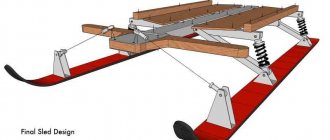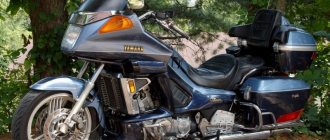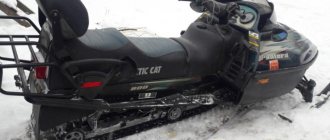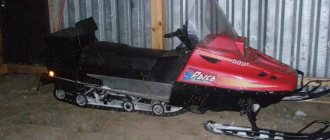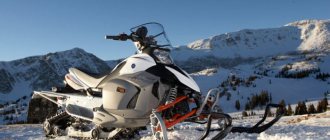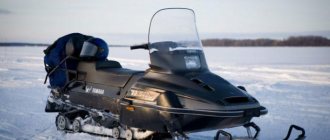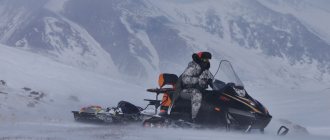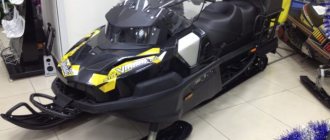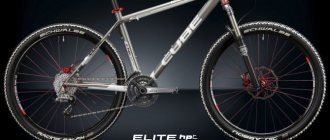Russian snowmobiles
The new 2-track snowmobile “Shikhan”, like the “Buran” known to compatriots, is focused on the purely Russian characteristics of climate and landscape.
This is a snow all-terrain vehicle for work, recreation, hunting and fishing in the most difficult natural conditions.
Its design feature is one spring swivel ski plus two tracks 38 cm wide and 287.85 and 368.65 long in 1- and 2-seater models.
Its side trusses are open, and its high and spacious cargo compartment allows you to go on long and long journeys.
Description of the model range
Currently, the Shikhanov model range is represented by the following models:
K-1/K-1E. A 1-seat super all-terrain snowmobile with an improved short frame, the snowmobile quickly cleans itself and allows for quick inspection of the undercarriage thanks to its open trusses.
1 ski provides excellent maneuverability among bushes and small trees
K-2/K-2E . Short, improved frame with a wide 2-seater seat, traditionally open side trusses.
It is especially popular among hunters and fishermen who like to hunt in winter and early spring.
Because stuck snow and ice are removed quickly and easily from such a frame, if you need to inspect the chassis on the road, then this is no longer a problem. During movement, the frames self-clean.
D-1/D-1E . The total area of 2 tracks is 3686.5 millimeters - this guarantees an increased support area, which reduces the pressure on the ground, and therefore increases the cross-country ability of the snowmobile.
It easily moves on fresh snow even with a loaded sled weighing 350 kilograms.
1 ski provides easy maneuverability among any forest obstacles. The wide 1-seater seat has a large luggage compartment underneath, which is appreciated by hunters and winter fishing enthusiasts.
D-2/D-2E . The 2-seater extended frame with a wide, comfortable seat and large luggage compartment is especially attractive for long-distance travel enthusiasts.
Open side trusses ensure easy self-cleaning of adhered snow and ice; the increased track area provides little pressure on the ground, be it loose fresh snow or swamp porridge.
A 1 ski increases the maneuverability of the snowmobile. Even if a load of 350 kilograms is attached to it.
We present to your attention a video of a Suzuki Hayabusa where an experienced driver wedges himself into a dense line of cars, in some moments it even takes your breath away.
What types of waterproof DVRs for motorcycles are available, read our article.
How to make a snowmobile
You can make a snowmobile from different vehicles that are in the garage.
From a motorcycle
You can make a snowmobile from a motorcycle using different models. The most popular are IZH and Ural. The advantages of such a rework are that no special changes need to be made. If the product is in good condition, you can even keep the original frame.
The conversion technology is as follows:
- Make a rectangular frame from metal pipes or appropriate corners. Its optimal dimensions are 150*43.5 cm.
- In addition to the IZh motorcycle, it is necessary to make a steering beam. It is made from metal corners. The optimal dimensions are 50*50*5 mm. Additionally, the beam is sheathed with metal plates.
- After this, it can be installed horizontally on the drilling machine. Treat the connection area. Do the same with the frame. In these places you need to make special grooves for reliable fixation. Additionally, attach a corner to the front frame.
- Now you can attach the seat for motorcyclists.
- You need to make holes in the side members.
- A channel must be placed between the front and middle parts of the frame to strengthen the structure.
- Regardless of whether the snowmobile is made from a Ural or another model of motorcycle, it is necessary to select a track sprocket and rubber band in advance. The optimal dimensions are 220*30 cm with a thickness of no more than 1 cm.
- Before installation, it is recommended to cover the track with nylon, which will allow the material not to delaminate during operation.
- Now you can move on to the transmission. It consists of two parts. The first, the front axle, is the drive axle. It is made of a tubular shaft, a track sprocket and a roller. The second is the rear axle. It is made from a caterpillar drum and a tubular shaft.
- You need to complete the snowmobile manufacturing process by welding sheet metal skis.
When converting a motorcycle into a snowmobile, it is important not to change the steering system. In the final product, this part must perform its original functions.
The principles of modification are the same, they do not depend on the vehicle model. But the snowmobile from the Ural motorcycle will be heavier.
From Zhiguli
The design of the car is characterized by simplicity, ease of operation and high maneuverability. To make it you need to follow the instructions:
- Frame assembly. It's better to make it from pipes. The frame consists of front and central beams (steel pipes with a diameter of 5 cm), two lower diagonal elements (bent pipes with a diameter of 3 cm) and a rear strut. Welding is used to fix the elements.
- Installation of steering columns. To do this, you need to place two bushings on the front beam.
- Fixing the axle shaft. It is located on the rear frame; first you need to weld the body under it. It is made from a metal pipe with a diameter of 6 cm. Secure the axle shafts using bushings and electric rivets.
- Installing a car engine. First you need to make the front and rear fastening units on the central beam of the frame. First they need to be placed on the engine itself, and only then welded to the frame.
- In a homemade snowmobile, you can install large diameter wheels or skis made of sheet metal. In the first case, the rear and front wheels need to be connected in pairs with a metal pipe. At the same time, make grooves in the hub for the bearings, which are subsequently secured with spring rings. Additionally, install a spacer between the bearings.
- Install a sprocket on each wheel depending on the expected maximum speed. This snowmobile can be used at any time of the year. For a snowy winter, a design in which the front wheels are replaced with skis is suitable.
- Installation of the steering system. It is taken whole from a car, for example, from a Zaporozhets, or a motorcycle. The choice depends on personal preference. In the first case, gas, clutch and brake pedals are additionally installed. The gearbox is controlled using a lever and a rigid rod.
- Installation of a snowmobile cabin, the role of which is played by the car body.
Snowmobiles sold in stores have a fairly high price and often do not fit into the budget. But you still need to move in the snow. Fishing, hunting and just active recreation in the wild require cross-country ability. Therefore, we will look at ways to make a snowmobile with your own hands.
Snowmobile from motorcycle
The first model was assembled at a service station from scrap parts, plus a little welding. The engine is from a Voskhod 1 motorcycle, the sled is welded from metal pipes.
Snowmobile from scooter
The engine is from a Honda 50cc scooter.
The frame is welded from a metal profile with a section of 50x50mm.
The caterpillar drive is made from an extended wheel and a support from the fret nine (VAZ 2109).
Shock absorber from am. Oka.
The caterpillar slides are made from water pipe.
The caterpillar was taken secondhand from an unknown model of snowmobile. The suspension is made for this track.
Video of the snowmobile in action
Homemade snowmobile
A serious design made according to all the canons of motorcycle construction.
The frame is welded from a profile pipe according to homemade drawings.
The following parts were purchased from the store:
Were purchased:
- Lifan 188FD engine with 13hp power. with electric starter
- 500mm wide caterpillar from Ryda motorized dog
- rollers from the Buran snowmobile
- driven and drive shafts with sprockets
- leading variator Safari and driven.
- Tiksi snowmobile slicks
- Windshield from a Tiksi snowmobile
- Atlant scooter headlight
- the hood is made from the hood of a VAZ2110
- Taiga snowmobile skis
Assembly photo:
Have you decided to make a snowmobile yourself? If there was a desire... Of course, to create a decent vehicle you will also need metalworking skills, basic knowledge of physics, ingenuity, materials, spare parts and some tools. There is no doubt that you have all this, and what you don’t can be acquired along the way. The main thing is what the result is! A self-made snowmobile moving on snow, overcoming snow-covered off-road terrain - that’s cool!
Manufacturer
The Shikhan snowmobile has been produced by Yaroslavl Off-Road Equipment since 2013.
Rania this model was called Irbis. All products of this enterprise are equipment for hunters, hunters and fishermen who need reliable modern equipment at reasonable prices.
The Shikhan snowmobile performed well both in the tundra and in the Siberian taiga.
The peculiarity of the new development of the enterprise - Shihan snowmobiles - is a modern design based on a reinforced chassis, wide seats that have a backrest and are 45 centimeters wide, which allow you to place spacious cargo compartments underneath.
Power steering and a single ski contribute to the unrivaled maneuverability of Shihan snowmobiles.
Yaroslavl Off-Road Equipment has a developed dealer network, so its products can be purchased throughout almost the entire territory of Russia.
How to make a snowmobile from a walk-behind tractor with tracks
Diagram of drive units and frame of a homemade snowmobile from a walk-behind tractor:
- homemade frame (1);
- second intermediate shaft sprocket with 17 teeth (2);
- intermediate shaft (3);
- first intermediate shaft sprocket, 21 teeth (4);
- track shaft driven sprocket, 37 teeth(5);
- track drive sprocket, 8 teeth (6); track drive shaft (7);
- two supports of the support ski, made of steel pipe 32x4 (8);
- two track tension rollers (9);
- the axis of the tension rollers is made of steel pipe (10);
- tow bar (11); tension device (12);
- four drum flanges made of steel sheet (13);
- four track sprocket flanges made of sheet steel (14);
- steering puff (15).
To place the engine with the subframe in the center of the front part of the frame, a platform was welded there in which holes were prepared for the “legs” of the subframe. Similar holes are made in the traverse. The holes in the “legs” of the subframe were converted into longitudinal slots to tension the drive chain when moving the engine.
The underframe has also been redesigned and moved back a little. Thanks to this, the engine is started on the handle. A big plus was the presence of a forced cooling walk-behind tractor on the engine. I used this to direct the air heated while cooling the engine to the carburetor. The gas tank was also moved to the body. It is installed there on stands in the corner to supply gasoline to the carburetor by gravity through a long hose.
Moving the engine to the center of the car resulted in increased stability. Thanks to this, the track of the steering skis was reduced to 950 mm, which led to improved maneuverability of the snowmobile.
After the intermediate shaft was installed, the angular velocity was reduced due to the increase in torque. The speed of the snowmobile was slightly reduced, but the traction characteristics were significantly increased. Now the snowmobile is able to carry two riders with a load, and pull a light sled with luggage. The drive sprockets of the caterpillar mover were also replaced with the same ones of a smaller diameter.
Diagram of a snowmobile steering column made from a walk-behind tractor
- Steering column diagram:
- front frame cross member (1);
- stand made of steel pipe (2);
- steering wheel support made from angle 25x25 (3);
- steering shaft made of steel pipe (4);
- crossbar made of steel pipe 28x28 (5);
- bipod (6); bronze washer (7);
- support sleeve with angle (8);
- nut, type M10 (9).
It was this small improvement that led to improved cross-country ability of the snowmobile. The sprocket has lifted above the support ski. As a result, the caterpillar reaches the upper layers of snow much easier, and also overcomes hummocks, sastrugi, etc. more confidently.
Diagram of the intermediate shaft assembly of a snowmobile from a walk-behind tractor
Intermediate shaft assembly diagram:
- seat support made of steel (1);
- frame cross member made of steel pipe 28x28 (2);
- stand made of steel pipe 18x18 (3);
- a traverse made from a 45x25 corner (4);
- a jib (5) made from a 40x5 steel plate;
- two bearings 204 in the housing (6);
- steel intermediate shaft made from 27x3 pipe (7);
- first sprocket with 21 teeth (8);
- frame spar (9);
- second sprocket with 17 teeth (10);
- rubber casing (11).
Checking the snowmobile before modernization revealed frequent sprocket teeth jumping onto the wooden track. Therefore, it was decided to cut off all the teeth, making them rollers. After modernization, the caterpillar transitions from skis to rollers smoothly, silently and without crackling. The tension mechanism has also been improved: it is now screw-type.
Specifications
| LxB | Russia 2878.5 by 380 mm |
| max slope on ascents and descents, degrees | 22 |
| variable speed drive | V-belt type |
| capacity | K-1 and D-1 - 1 person, K-2 and D-2 - 2 people |
| height with glass | 1450 mm |
| fuel | AI-80/AI-92 |
| caterpillar | reinforced rods and rubberized fabric |
| support pressure, kPa/kg/cm. | cube 5.58 (0.057) |
| engine | carburetor |
| crawler engine | drive shafts are located at the front |
| cylinder diameter/piston stroke, mm | 76/70 |
| length without ski/with ski | 2400/2800 |
| launch | manual, electric |
| ignition | contactless (electronics) |
| electrical energy source | Battery, 12 V/ 6CT - 44 A |
| carburetor 1 pc. (K-65 Zh) or 1 (Mikuni VM-34-619) | 2 stroke / 2 cylinder |
| reverse box | 1-speed (+ reverse gear) |
| ski | steel supporting and rotating 1 piece |
| maximum speed | 60 km/h |
| weight, kg unloaded/maximum loaded/trailer | 285/510/250 |
| JVT model | 640 |
| power max. | 25 kW/34 hp |
| appointment | cargo-passenger |
| fuel tank volume | 28 l |
| cooling | air, forced type |
| transmission to tracks | chain |
| checkpoint | manually, mechanics |
| track suspension | spring-balanced / ski elliptical spring |
| braking distances | maximum 10 meters |
| working volume | 635 cm3 |
| turning radius | maximum 8 m |
| variant belt | 33 by 14 by 1118 Rubena |
| steering wheel | motorcycle |
| lubricant | with fuel |
| speedometer | mechanical |
| brake | disc / parking + |
| transmission | automatic |
| width | 900 |
Features and advantages of homemade snowmobiles
The basis of the design of a winter vehicle is a caterpillar drive and steering skis. Of all the advantages of homemade snowmobiles over factory models, the following can be highlighted:
- The price of motorcycles assembled from scrap materials is 5-10 times lower.
- The ability to assemble a model of the desired configuration, power, etc.
- Reliability of the design, thanks to the use of high-quality materials and proven mechanisms.
- The benefit is that you don’t have to buy new materials and parts, but use those stored in the garage.
A homemade snowmobile is a vehicle that can be found not only on country roads and ski resorts, but also on the streets of populated areas.
Manufacturing a snowmobile according to drawings
How to make a snowmobile with your own hands, what parts and components will be needed? To create a homemade tracked vehicle for moving on snow, a list of necessary components is compiled, a sketch is made and drawings are made. In the future, they will serve as a guide for creating a vehicle.
The standard design consists of several elements. It includes:
- A frame that can be borrowed from an ATV, scooter, scooter, motorcycle, etc. If this is not possible, it is made by welding from thin-walled metal pipes with a diameter of 40 mm.
- The seat should preferably be made of water-repellent material.
- The engine can also be from a walk-behind tractor, motorcycle, scooter, etc. The choice is determined by the speed and weight of the vehicle.
- A tank, which is a 10-15 liter container made of metal or plastic.
- Skis for a homemade snowmobile on tracks can be taken ready-made or made from nine to ten-layer plywood, 3 mm thick.
- The steering wheel, like many other elements, is taken from a two-wheeled unit.
- A drive that transmits rotational movements from the engine to the track, which can be a motorcycle chain.
- The caterpillar is a complex component that requires detailed consideration.
How to make caterpillars with your own hands?
Homemade tracks can be made from car tires. The advantage of using tires is that they have a closed circuit, which reduces the likelihood of bursting. To make tracks, the tire beads are cut off with a sharp shoe knife. Grousers are attached to the remaining flexible web, which are made from plastic pipes 5 mm thick and 40 mm in diameter, sawn to length. The pipe halves are cut to the width of the tire and bolted every 5-7 cm.
Caterpillars are made from a conveyor belt in a similar way. Its advantage is that if it is used, there are no restrictions on length. But there is a need for coupling by overlapping the ends of the tape with an overlap of 3-5 cm and fixing with bolts. When making tracks with your own hands, V-belts are often used. Connected by lugs, they represent a full-fledged caterpillar with ready-made cavities for gears.
A wide track improves the cross-country ability of the unit, but reduces its controllability. Factory models have three options:
- Standard – 15;
- Wide – 20;
- Ultrawide – 24.
The sequence of creating a snowmobile with your own hands
To make a snowmobile on tracks with your own hands, you first need to connect the frame and steering mechanism. The height and angle of inclination are selected, then spot welding is performed. In accordance with the drawing, the engine is installed and fixed. It is necessary to ensure that there is no strong tilt. To avoid a long fuel line, the tank is located at a close distance from the carburetor.
Next, the caterpillar is installed. The driven axle with the canvas is attached behind the frame (depending on the design, on a suspension, fork, shock absorber, etc.), the drive axle is attached in the middle of the snowmobile (usually under the driver’s seat), closer to the engine. The axle gears are pre-engaged. After this, the fuel tank, throttle and brake cables are connected, the seat is mounted, and other work is carried out.
Do-it-yourself snowmobile from a walk-behind tractor
Creating a snowmobile from a walk-behind tractor is the most popular option. A vehicle intended for agricultural work can be used in whole or in part. It should be noted that walk-behind tractor engines, as a rule, are designed for the weight and pressure of wheels, which are several times smaller than a caterpillar wheel. For this reason, it is better to equip your snowmobile with low-pressure wheels. This will help avoid excessive fuel consumption and premature wear of parts. How to transform a walk-behind tractor into a homemade snowmobile, watch the video.
itemprop="video" >
When making a snowmobile, you need to listen to the advice of experienced craftsmen:
When cutting pipe with a circular saw, it is recommended to cut one side and then the other. This way you will be able to get even workpieces. It is better to first cut the pipe into pieces of the required length, since when cutting long pieces, the plastic will melt and the saw blade may jam.
The size of the caterpillar can be chosen at your discretion. It can be wide and short, narrow and long, but it should be taken into account that the controllability of the vehicle will depend on its width. A vehicle with a wide track is more difficult to control, and the load on the engine will also increase. A small track will sink in deep, loose snow.
A crawler snowmobile made from a walk-behind tractor is perfect for moving through snow-covered forests, overgrown hummocks, and frozen swamps. The machine is manufactured over the summer, using simple tools: metal jigsaw, electric drill, chisel and hammer, welding, etc. You will also need electric welding. Bearings can be purchased at an auto store, and shaft ends can be ordered at a workshop.
Estimated cost
The approximate cost of Shikhan snowmobiles models K-1/K-1E, K-2/K-2E in most stores is 172,000 rubles at the beginning of 2016.
Models D-1/D-1E, D-2/D-2E - 183,000 rubles. As you can see, the amounts are quite affordable and accessible.
Used Shirkhan snowmobiles can traditionally be purchased for half the price if they are in good condition. Equipment that requires repair can be purchased for mere pennies.
We bring to your attention a video of Kawasaki Vulcan, this is an excellent Japanese cruiser, which is made in the American classic style.
The main advantages of mini snowmobiles are their price and compactness.
Photo gallery
The photo below shows a powerful domestic unit, which is currently the leader in cross-country ability in forest conditions. Confident movement in deep snow provides unsurpassed maneuverability in both snowy forests and swamps.
Selection by purpose
All snowmobiles are divided into several large groups according to their intended purpose:
Utilitarian
. One of the most popular categories, created for work. Utility snowmobiles have a reliable and simple design, resistant to long-term use and operation under heavy load. They come in single- and double-seaters and can have motors of different power - from economical to very powerful. They often have a loading area. The front suspension is telescopic or wishbone. The track is usually 500 or 600 mm wide. This type of equipment is used to go hunting and fishing, to transport firewood or provisions, and to drive through snowy expanses.
Popular and powerful utilitarian snowmobile RM Varyag 550
Tourist
. Technically, they are in many ways similar to utilitarian ones. The differences include more comfort options and a more interesting design. Ideal for flat fields and snowy roads with dense and not very deep snow.
Sports
. Designed for prepared trails or jumps. They have powerful engines, light weight, a short tunnel, a narrow seat, a short and narrow track with a small lug. An important point: sports snowmobiles are designed for extreme sports, but are not suitable for other conditions and tasks (for example, traveling through forests or mountain slopes, and especially for transporting goods).
Mountain
. Designed for high slopes and deep untouched snow. They have powerful engines (often with a turbine), long narrow tracks with large (up to 76 mm) lugs, and a lightweight body with a short tunnel.
Crossovers
. Universal equipment that combines the characteristics of mountain and utilitarian snowmobiles. Some manufacturers do not classify their snowmobiles as crossovers, even if in practice they are.
